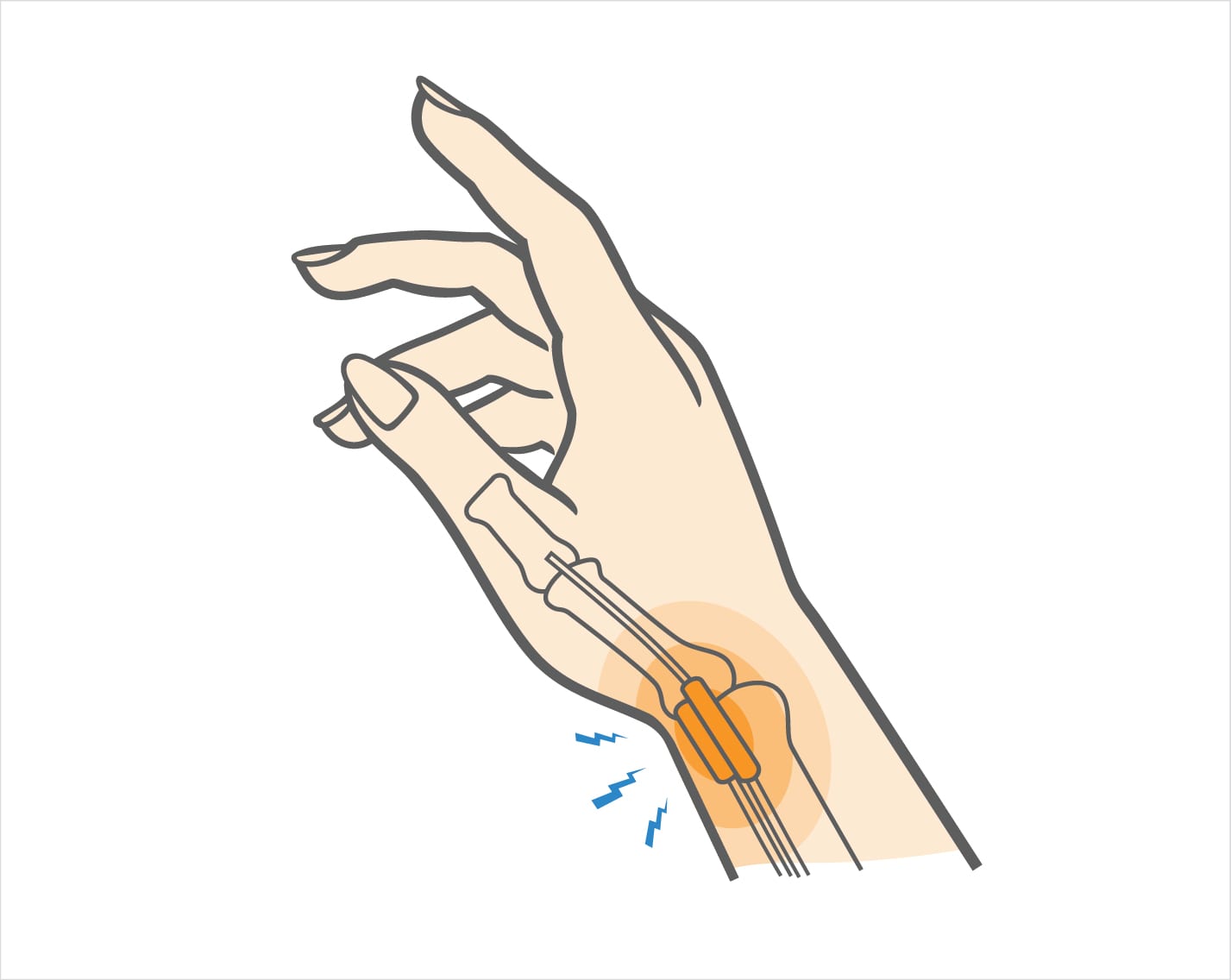De Quervain’s tenosynovitis is a painful condition marked by swelling of the tendons on the thumb side of the wrist. Tendons are tough, fibrous cords that connect muscle to bone and allow the fingers and thumb to move. Tendons normally glide through a sheath when your muscles contract, allowing your fingers and thumb to bend. When the tendons become inflamed and swollen, they can’t easily move through the sheath, causing irritation and pain.
De Quervain’s Tenosynovitis Causes, Symptoms & Treatment
De Quervain’s tenosynovitis is a painful condition marked by swelling of the tendons on the thumb side of the wrist. This thumb-side wrist pain is commonly associated with radial wrist inflammation. Tendons are tough, fibrous cords that connect muscle to bone and allow the fingers and thumb to move. Tendons normally glide through a sheath when your muscles contract, allowing your fingers and thumb to bend. When the tendons become inflamed and swollen, they can’t easily move through the sheath, causing tendon sheath pain, irritation, and discomfort.
Overview
Overview

What causes De Quervain’s Tenosynovitis?
De Quervain’s tenosynovitis is thought to be caused by chronic, repetitive motion injury involving the wrist and thumb. It is most common in these sports:
- Racket sports (tennis, racketball, squash)
- Golf
Symptoms
Athletes with de Quervain’s tenosynovitis often feel pain when making a fist or grasping motion. Other common symptoms include:
- Pain (sharp or dull) at the base of the thumb
- Swelling on the thumb side of the wrist
- Thumb-side wrist pain that spreads further into the thumb and forearm
- Catching or snapping sensation when moving the thumb
When to see a doctor
Athletes with symptoms of de Quervain’s tenosynovitis can try at-home care treatments, such as resting the affected thumb, applying a cold pack, and taking nonsteroidal anti-inflammatory (NSAID) medication like ibuprofen. If symptoms persist, you should see your doctor.
During your visit, your doctor will examine your hand and wrist to see where it hurts. He or she may ask you to perform the Finkelstein test, a simple diagnostic test that stretches your tendons by bending your fingers over your thumb to make a fist.
Non-operative treatment
To relieve pain and swelling caused by de Quervain’s tenosynovitis, your doctor may recommend conservative treatments, including the following:
- Splint: A splint may help rest the thumb and wrist.
- Medication: Nonsteroidal anti-inflammatory (NSAID) medication like ibuprofen can be used for pain relief.
- Steroid Injections: Corticosteroid injections (anti-inflammatory agents) can reduce swelling and pain.
- Physical Therapy: Gentle exercises can help reduce stiffness and increase mobility in your finger and alleviate tendon sheath pain.
Try these exercises to help address your condition:
Below is a PDF of the exercise program.
Surgical Treatment
If conservative treatment options are not successful in relieving your symptoms, your doctor may recommend surgery. Your surgeon will open the sheath around the swollen tendon, providing more room for the tendons in your hand to relieve irritation and pain. This is typically considered when the repetitive motion injury has led to chronic discomfort and dysfunction.
Recovery
Athletes can expect to return to their normal activities, though a full return to play can take several weeks. Moderate activity usually can begin sooner. Your doctor may recommend wearing a brace while at play, as well as physical therapy to speed the recovery process and address ongoing radial wrist inflammation.
GET BACK TO WHAT YOU LOVE. FASTER
Sources
https://orthoinfo.aaos.org/en/diseases–conditions/de-quervains-tendinosis/
https://www.mayoclinic.org/diseases-conditions/de-quervains-tenosynovitis/symptoms-causes/syc-20371332
http://www.assh.org/handcare/hand-arm-conditions/de-quervain-tenosynovitis
https://www.webmd.com/rheumatoid-arthritis/guide/de-quervains-disease#1
https://www.sports-health.com/treatment/hand-and-wrist-injury-treatment/recovering-de-quervains-tenosynovitis-surgery
Frequently Asked Questions
What’s the risk of misdiagnosis if symptoms are mild or sporadic?
Mild symptoms might be overlooked or attributed to overuse without a proper exam, delaying diagnosis. This may prolong tendon sheath pain and result in worsening radial wrist inflammation.
How long should I try conservative treatment before considering surgery?
If non-operative care (rest, NSAIDs, splints, etc.) shows no improvement within 6-12 weeks, your doctor may explore surgical options, especially if the injury has progressed significantly.
Is it common for De Quervain’s Tenosynovitis to return after treatment?
Recurrence can happen, particularly if the root cause—like repeated wrist use—is not addressed. Proper healing and avoiding repeated thumb-side wrist pain triggers are essential.
How long does full recovery take after surgery for De Quervain’s Tenosynovitis?
Full recovery typically ranges from 6 to 12 weeks. Wearing a brace and undergoing physical therapy helps reduce radial wrist inflammation and support long-term healing.

